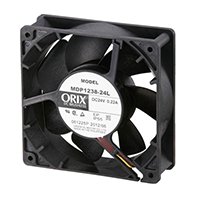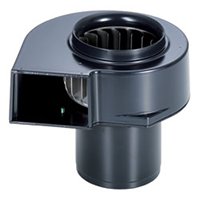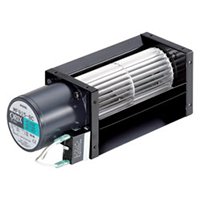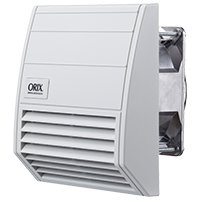Cooling Fans Structure, Air Flow Static Pressure Characteristics, and Heat Protection
Overheated equipment can lead to many problems, including failure, shorter product life, early deterioration of parts, malfunction, and other safety risks. Cooling fans and blowers are essential to applications in the presence of heat. In order to avoid these problems, the appropriate cooling unit for these systems must be selected.
The features of cooling fans differ according to their air-blowing system. The following explains the structure of axial fans, centrifugal blowers and cross flow fans, as well as air flow-static pressure characteristics. Overheat protection is also discussed through the use of low-speed alarms, stall alarms, and thermal protectors.
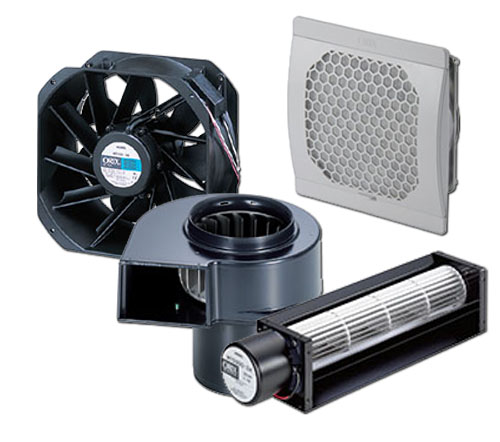
Axial Fans
The propellers (fan blades) located in the circular flow path between the cylindrical hub and casing are used to force-feed air in order to generate air flow in the direction of the axis of rotation.
Since air flows along the axis of rotation, the structure is kept compact. Capable of generating a large air flow, axial fans are suited for applications requiring ventilation cooling where the entire space inside the equipment must be cooled.
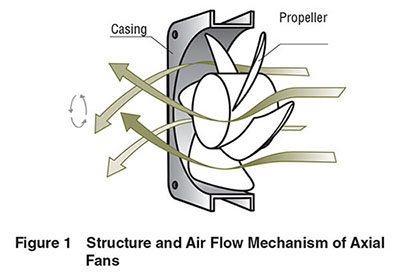
Centrifugal Blowers
The centrifugal force of the cylindrically positioned runner (forwardfacing blades) generates rotational flows roughly perpendicular to the axis of rotation. The generated rotational flows are aligned in a uni-direction through scroll action, and the pressure rises accordingly.
Since the exhaust outlet is reduced to focus air in a specified direction, these blowers are used for spot cooling. The static pressure is also high, which makes them a suitable choice when cooling equipment through which air cannot flow easily or when blowing air using a duct.
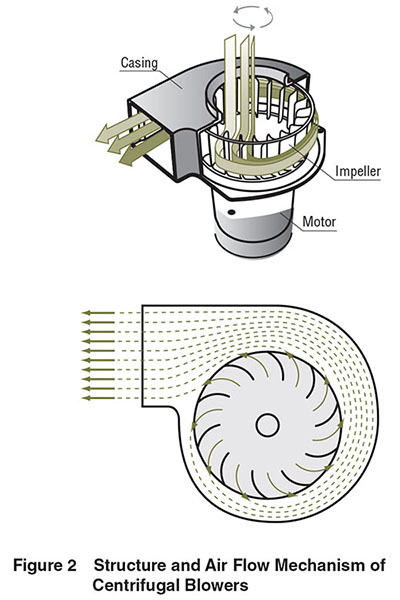
Cross Flow Fans
A cross flow fan has an impeller similar to that of a centrifugal blower, but both sides of the fan are covered with side panels and thus no air enters from the axial direction. As a result, air flows that pass through the impeller are generated. Cross flow fans utilize these air flows. Since a long cylindrical impeller is used to blow air, air travels over a wide width. Also, uniform air can be achieved because air is exhausted sideways along the circumference of the impeller.
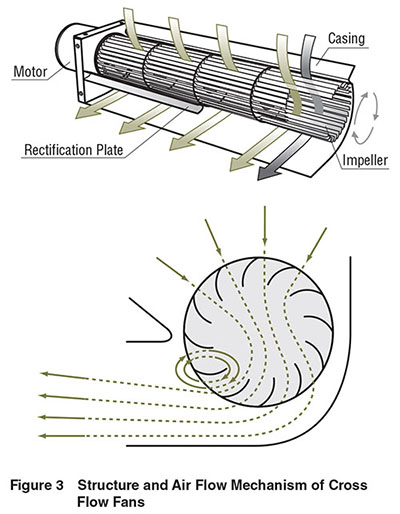
Air Flow- Static Pressure Characteristics
Pressure Loss
When air flows along a certain path, air flow resistance is produced by anything in the path that inhibits the flow. Comparing the cases illustrated in Figure 4 and Figure 5, we see that the device shown in Fig. 4 is almost empty, so there is almost no air flow resistance in the device and little decline in the air flow. By contrast, there are many obstructions of the air flow in the device shown in Fig. 5, which increases air flow resistance and decreases air flow.
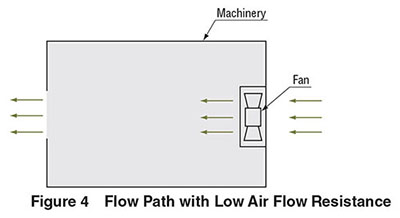
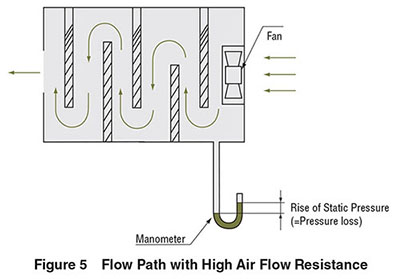
This situation is very similar to the role of impedance in the flow of electrical current: when impedance is low, the current flow is large, and when impedance is high, the current flow is low. The air flow resistance becomes the pressure energy that increases the static pressure within the device. This is called pressure loss. Pressure loss is determined using the following formula:
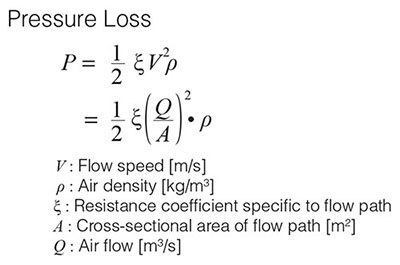
In terms of the fan, this formula says that to achieve a certain air flow (Q), the fan must be able to supply static pressure sufficient to increase the pressure inside the device by
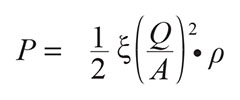
Air Flow- Static Pressure Characteristics
Fan characteristics are generally expressed in terms of the relationship between air flow and the static pressure required to generate such air flow, given as air flow – static pressure characteristics. As an example,assume the air flow required is Q1 and the accompanying pressure loss of the device is P1.
When the fan characteristics are as shown in Figure 6, the fan is capable of a staticpressure of P2 at an air flow of Q1. This is more than sufficient for the required air flow, since it exceeds the required static pressure value of P1.
Since pressure loss is proportional to the square of the air flow, if the air flow needs to be doubled, then the fan chosen must be capable of providing not only twice the air flow but four times the static pressure, as well.
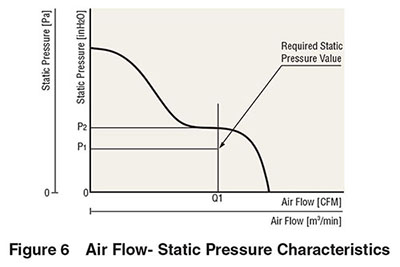
Protection & Alarms Offered for Fan Products
Applications that needs consistent airflow to cool can be adversely affected when fans slow down over time thus decreasing airflow. Low airflow will not provide the proper cooling, which may cause problems with motor components.
If this is an issue, consider fans with impedance protection, over heat protection, low speed alarms, or stall alarms. Impedance protection and overheat protection prevents damage to the fan motor while the speed alarms ensures the performance you expect and allows planning of replacements more efficiently.
For low fan speed issues, we suggest looking at fans with either a low speed alarm, stall alarm, or pulse output. Fans with low speed alarms output an alarm signal when the fan speed drops to a certain level due to either end of life or ingress of foreign objects. Fans with stall alarms output an alarm signal when the cooling fan stops. These types of alarm are offered on MRS and MRE series AC axial fans, MDS and MDA series DC axial fans, MBD series DC centrifugal blowers and MFD series DC cross flow fans.
Fans with Low-Speed Alarms
An alarm is output when the fan speed drops due to the service life of the fan or the ingress of foreign objects. This makes it possible to order and replace the fan with a new one before it stops. If multiple cooling fans are being used, it is possible to only replace the cooling fan with decreased cooling capacity. Even if the cooling capacity of the fan decreases, the effect of that on the equipment can be minimized.
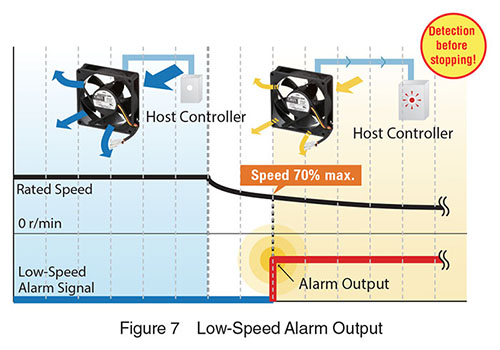
Fans with Stall Alarms
Stall alarms work by sending an alert when the fan stops. They quickly detect defective stops to allow the cooling fan to be replaced.
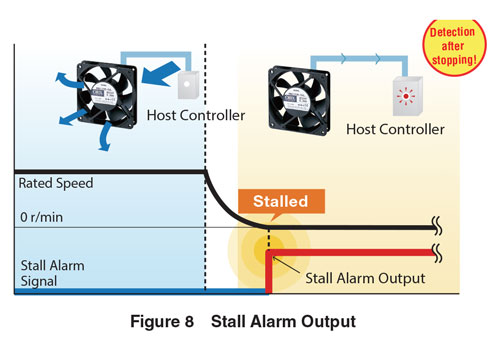
Overheat Protection Device
If a fan in run mode locks due to overload, ambient temperature rises rapidly, or the input current increases for some reason, the fan's temperature rises abruptly. If the fan is left in this state, the performance of the insulation within the fan may deteriorate, reducing its life and, in extreme cases, scorching the winding and causing a fire. In order to protect the fan from such thermal abnormalities, our fans recognized by UL and CSA Standards and conform to EN and IEC Standards are equipped with the following overheat protection device.
Thermal Protector
The MRS Series, MB Series (impeller diameter ϕ80 mm (3.15 in.) or more) and MF Series fans contain a built-in automatic return type thermal protector. The structure of a thermal protector is shown in the figure below. The thermal protectors employ bimetal contacts, with solid silver used in the contacts. Solid silver has the lowest electrical resistance of all materials, along with a thermal conductivity second only to copper.
Operating Temperature of Thermal Protector
![]()
(The fan winding temperature, where the thermal protector is activated, is slightly higher than the operating temperature listed above.)
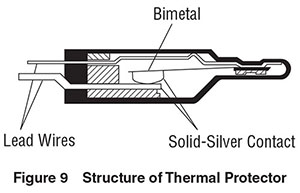
Impedance Protected
The MU and MB Series (MB520 and MB630 type) fans are equipped with impedance protection. Impedance protected fans are designed with higher impedance in the fan windings so that even if the fan locks, the increase in current (input) will be minimized and the temperature will not rise above a certain level.
Glossary
Decibels (dB)
Noise level is expressed in decibel units (dB). When the noise level is expressed based on the linear scale, with the minimum level of noise audible to the human ear being 1, the maximum level of noise the human ear can withstand is expressed in such a substantial figure as 5 million. In contrast, if noise (sound pressure level) is expressed in decibels, then
Therefore, the range of sound pressure audible to the human ear can be conveniently expressed as 0 to 130 dB.
A-Weighted Sound Pressure Level
It is generally said that the audible range of the human ear is between 20 Hz and 20 kHz. Moreover, low frequency and extremely high frequency sounds are not disturbingly loud to the human ear. For this reason, an accurate indication of loudness as perceived by the human ear cannot be achieved simply by measuring sound pressure without taking frequency into account. Therefore, measurements of the sound pressure level must be corrected according to frequency in order to accurately reflect the human perception of loudness. This corrected level is called the A-weighted sound pressure level. Figure 8 compares the corrected measured values (A-weighted sound pressure level) with the uncorrected measured values (C-weighted sound pressure level).
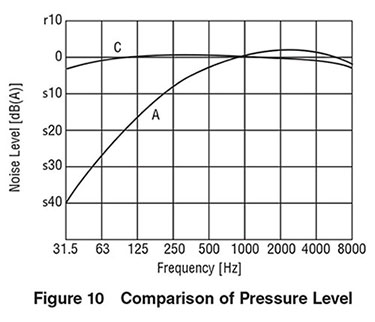
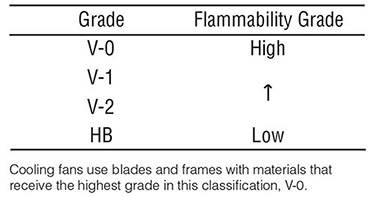
Flammability Grade
The flammability grade represents the degree of fire retardancy for plastic materials used in equipment parts. The generally accepted standards for flammability grade are the UL Standards (UL94, STANDARD FOR TESTS FOR FLAMMABILITY OF PLASTIC MATERIALS FOR PARTS IN DEVICES AND APPLIANCES). The UL Standards provide the flammability of plastic materials based on the burning rate, duration of burning from the onset of fire, fire ignited by a dripping substance and other items. Flammability grade is rated in four different grades, as shown in the table below.
